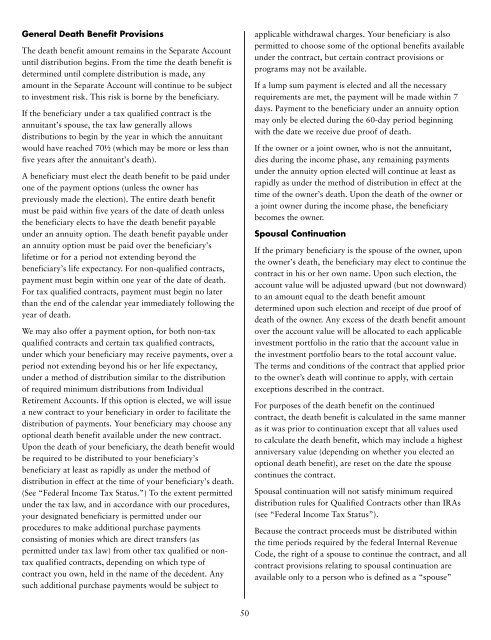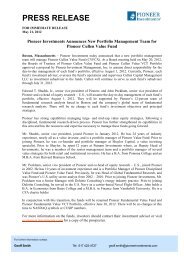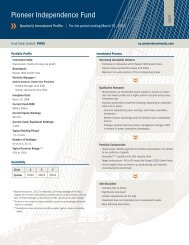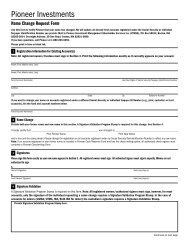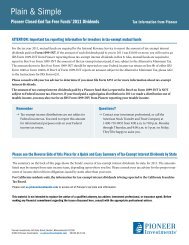Pioneer PRISM XC Variable Annuity - Pioneer Investments
Pioneer PRISM XC Variable Annuity - Pioneer Investments
Pioneer PRISM XC Variable Annuity - Pioneer Investments
Create successful ePaper yourself
Turn your PDF publications into a flip-book with our unique Google optimized e-Paper software.
General Death Benefit Provisions<br />
The death benefit amount remains in the Separate Account<br />
until distribution begins. From the time the death benefit is<br />
determined until complete distribution is made, any<br />
amount in the Separate Account will continue to be subject<br />
to investment risk. This risk is borne by the beneficiary.<br />
If the beneficiary under a tax qualified contract is the<br />
annuitant’s spouse, the tax law generally allows<br />
distributions to begin by the year in which the annuitant<br />
would have reached 70½ (which may be more or less than<br />
five years after the annuitant’s death).<br />
A beneficiary must elect the death benefit to be paid under<br />
one of the payment options (unless the owner has<br />
previously made the election). The entire death benefit<br />
must be paid within five years of the date of death unless<br />
the beneficiary elects to have the death benefit payable<br />
under an annuity option. The death benefit payable under<br />
an annuity option must be paid over the beneficiary’s<br />
lifetime or for a period not extending beyond the<br />
beneficiary’s life expectancy. For non-qualified contracts,<br />
payment must begin within one year of the date of death.<br />
For tax qualified contracts, payment must begin no later<br />
than the end of the calendar year immediately following the<br />
year of death.<br />
We may also offer a payment option, for both non-tax<br />
qualified contracts and certain tax qualified contracts,<br />
under which your beneficiary may receive payments, over a<br />
period not extending beyond his or her life expectancy,<br />
under a method of distribution similar to the distribution<br />
of required minimum distributions from Individual<br />
Retirement Accounts. If this option is elected, we will issue<br />
a new contract to your beneficiary in order to facilitate the<br />
distribution of payments. Your beneficiary may choose any<br />
optional death benefit available under the new contract.<br />
Upon the death of your beneficiary, the death benefit would<br />
be required to be distributed to your beneficiary’s<br />
beneficiary at least as rapidly as under the method of<br />
distribution in effect at the time of your beneficiary’s death.<br />
(See “Federal Income Tax Status.”) To the extent permitted<br />
under the tax law, and in accordance with our procedures,<br />
your designated beneficiary is permitted under our<br />
procedures to make additional purchase payments<br />
consisting of monies which are direct transfers (as<br />
permitted under tax law) from other tax qualified or nontax<br />
qualified contracts, depending on which type of<br />
contract you own, held in the name of the decedent. Any<br />
such additional purchase payments would be subject to<br />
applicable withdrawal charges. Your beneficiary is also<br />
permitted to choose some of the optional benefits available<br />
under the contract, but certain contract provisions or<br />
programs may not be available.<br />
If a lump sum payment is elected and all the necessary<br />
requirements are met, the payment will be made within 7<br />
days. Payment to the beneficiary under an annuity option<br />
may only be elected during the 60-day period beginning<br />
with the date we receive due proof of death.<br />
If the owner or a joint owner, who is not the annuitant,<br />
dies during the income phase, any remaining payments<br />
under the annuity option elected will continue at least as<br />
rapidly as under the method of distribution in effect at the<br />
time of the owner’s death. Upon the death of the owner or<br />
a joint owner during the income phase, the beneficiary<br />
becomes the owner.<br />
Spousal Continuation<br />
If the primary beneficiary is the spouse of the owner, upon<br />
the owner’s death, the beneficiary may elect to continue the<br />
contract in his or her own name. Upon such election, the<br />
account value will be adjusted upward (but not downward)<br />
to an amount equal to the death benefit amount<br />
determined upon such election and receipt of due proof of<br />
death of the owner. Any excess of the death benefit amount<br />
over the account value will be allocated to each applicable<br />
investment portfolio in the ratio that the account value in<br />
the investment portfolio bears to the total account value.<br />
The terms and conditions of the contract that applied prior<br />
to the owner’s death will continue to apply, with certain<br />
exceptions described in the contract.<br />
For purposes of the death benefit on the continued<br />
contract, the death benefit is calculated in the same manner<br />
as it was prior to continuation except that all values used<br />
to calculate the death benefit, which may include a highest<br />
anniversary value (depending on whether you elected an<br />
optional death benefit), are reset on the date the spouse<br />
continues the contract.<br />
Spousal continuation will not satisfy minimum required<br />
distribution rules for Qualified Contracts other than IRAs<br />
(see “Federal Income Tax Status”).<br />
Because the contract proceeds must be distributed within<br />
the time periods required by the federal Internal Revenue<br />
Code, the right of a spouse to continue the contract, and all<br />
contract provisions relating to spousal continuation are<br />
available only to a person who is defined as a “spouse”<br />
50


